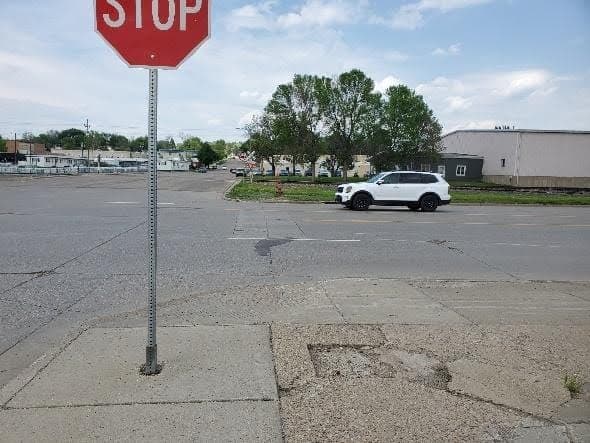
News
By Guest Contributor, May 30, 2024
This case study was written as part of our Dangerous by Design Technical Assistance program. This initiative brought together champions from across the country to advance street safety efforts through data collection and storytelling. This study was written by Kimberly Riepl from Bismarck-Mandan MPO.

Image of the intersection of 24th Street at Main Avenue. Kim said that although there is a sidewalk on this side with a pedestrian ramp to indicate this may be a crossing, there are no other signs or markings for a pedestrian crossing here. Also, she notes that there is no sidewalk along either 24th Street or Main Avenue on the north side.
Bismarck is a small city that has not made any “most dangerous” or “deadliest” streets rankings compared to larger metropolitan areas. However, that does not mean it is safe for people walking, and there is always room for improvement to avoid injury or loss of life on the streets caused by traffic violence. In 2015, a 53-year-old man was killed by a driver switching lanes at the intersection of 24th Street and Main Avenue. The man was crossing Main Avenue, which has no pedestrian amenities.
“One life lost on our streets is one too many, and we don’t want to see the pedestrian serious injury or death toll statistics rise.” – Kim Riepl, Transportation Planner, Bismarck-Mandan MPO
Background
East Main Avenue is a freight corridor, part of Bismarck’s truck route system, but it runs through the city, right next to a commercial area. The posted speed limit is 35 mph on this five-lane roadway, but the width of the road encourages speeding. At the intersection where this man was killed, North 24th Street is as wide, about 68’ from curb to curb, about as wide as the five lanes it crosses. It has no sidewalk on the east side and only a corner pedestrian landing with curb cuts on the west side.
Near this corridor, there are several organizations that serve persons of unsheltered or low-income status. Many people who seek these services don’t have a vehicle or access to transit for travel, creating significant foot traffic and bicycle activity in the area that could be better supported with street design changes.


The two photos above show a busy intersection made safer by pedestrian-actuated signals with countdown timers and pedestrian lead times in conjunction with “No Turn on Red” for all legs of the intersection and complete with a pedestrian refuge island.
“If a plane crashed on the other side of the world, it’s front page news. We’re killing a planes worth everyday, and it’s been happening for decades.” -Gov. Doug Burgum
Taking Action

Image of a HAWK signal in use.
Promoting safe pedestrian and bicycle connections in this area will require building on the recommendations from the East Main Avenue Corridor Study and the ongoing Safe Routes to Services Study (anticipated completion Dec. 2024). This will include having discussions with stakeholders most impacted by potential improvements, Public Works, NDDOT District Office, and the NDDOT Vision Zero team. It will also require exploring funding opportunities that would provide the most expedient implementation, as the city lacks a safety action plan at this time.
The City of Bismarck has taken a very proactive approach to identifying and implementing safety improvements within the urban area. Since 2020, the Highway Safety Improvement Program (HSIP) and Transportation Alternatives/Safe Routes to School funds, along with other federal sources in excess of $14.52 million, have been successfully secured and leveraged for construction and safety projects that have benefited pedestrians. They have initiated tools such as the Sidewalk Suggestion Tool to identify gaps in the city’s sidewalk network.
There are numerous other projects currently underway that will increase pedestrian access and safety. Bismarck has applied for FY27 Urban Grant Program funds for a reconstruction on Main Ave between 7th and 9th St to include a lane reduction, the addition of on-street parking, wider ADA-compliant pedestrian facilities, crossing and pavement markings, and pedestrian lighting. The vision for this project was the result of a collaborative effort between the North Dakota Department of Transportation, the City of Bismarck, and the Bismarck-Mandan MPO. The City of Bismarck and the MPO will continue to partner on studies that explore pedestrian and bicyclist needs and implement strategies to enable safe use by all.
Related News

© 2025 Smart Growth America. All rights reserved
Site By3Lane Marketing
























